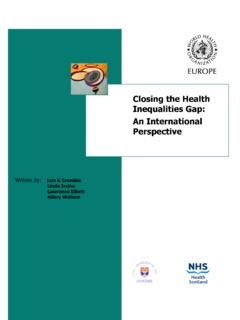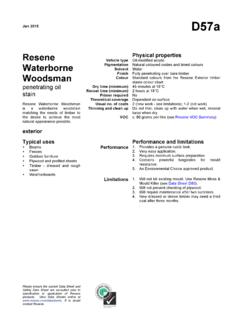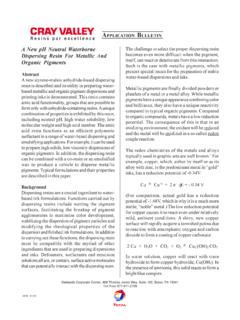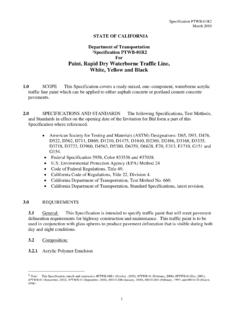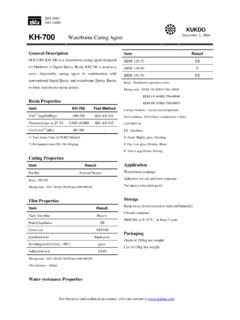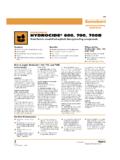Transcription of OUTBREAKS OF WATERBORNE DISEASES - …
1 OUTBREAKS OF WATERBORNE DISEASES . FACT SHEET z December 2009 z CODE: RPG1_WatSan_E1. Number of OUTBREAKS of WATERBORNE DISEASES attributable to drinking-water and bathing water each year This summary is based on data describing OUTBREAKS of WATERBORNE DISEASES related to drinking-water and bathing water. An outbreak of WATERBORNE dis- ease is generally defined as a situation in which at least two people experience a similar illness after exposure to water and the evidence suggests a probable water source. The document also contains information on the environment and health context and on the policy relevance and context, as well as an as- sessment of the situation in the WHO European Region and suggestions for further monitoring. JJJ KEY MESSAGE.. The indicator shows that, between 2000 and 2007 in 14 European countries, there were 354 OUTBREAKS of WATERBORNE DISEASES related to drinking-water, resulting in over 47 617 episodes of illness.
2 The data must be interpreted cau- tiously, as differences between countries are likely to reflect the efficiency of surveillance systems rather than differences in OUTBREAKS , and data were available for only 14 countries. This underlines the need for more widespread and effective surveillance systems. Also, as the provision of adequate water and sanitation is associated with OUTBREAKS of disease , the successful efforts to improve coverage in recent years must be continued. JJJ RATIONALE. Safe drinking-water and bathing water are vital for the health of the popula- tion, particularly children. The number of OUTBREAKS of WATERBORNE DISEASES provides an indication of the quality of the drinking-water or bathing water. JJJ PRESENTATION OF DATA. Fig. 1 shows the number of OUTBREAKS of disease arising from drinking-water reported in Belgium, Croatia, the Czech Republic, Estonia, Finland, Greece, Hungary, Italy, Lithuania, Norway, Slovakia, Spain, Sweden and the United Kingdom (England and Wales) from 2000 to 2007.
3 OUTBREAKS were seen in all reporting countries except Estonia. Fig. 2 shows the number of episodes of illness attributable to OUTBREAKS of dis- ease carried in drinking-water reported in the same countries over the same period. The data reflect cases in whole populations, as child-specific data are not available. Fig. 1. Number of reported OUTBREAKS of DISEASES arising from drinking-water in selected European countries, 2000 2007. Source: Surveys of various national agencies (see below under Data underlying the indicator). Fig. 2. Number of reported episodes of illness attributable to DISEASES carried in drinking- water in selected countries, 2000 2007. Notes. Child-specific data are not available. The number of cases is shown on a log scale. Source: Surveys of various national agencies (see below under Data underlying the indicator).
4 2. JJJ HEALTH AND ENVIRONMENT CONTEXT. WATERBORNE DISEASES arise from the contamination of water, either by pathogenic viruses, bacteria or protozoa or by chemical substances. These agents are directly transmitted to people when the water is used for drinking, preparing food, recreation or other domestic purposes. An outbreak of WATERBORNE disease is usually defined as an event meeting two criteria: (a) at least two people have experienced similar illness after exposure to water; and (b) epidemiological evidence implicates water as the prob- able source of the illness. The occurrence of OUTBREAKS of WATERBORNE DISEASES is not limited to devel- oping countries; affluent countries are also affected (1 5). Drinking-water The risk of OUTBREAKS of WATERBORNE DISEASES increases where standards of water, sanitation and per- sonal hygiene are low.
5 Worldwide, the proportion of people with access to safe drinking-water and ba- sic sanitation rose from 78% in 1990 to 83% in 2004. Despite this progress, however, an estimated 425 million children under 18 years of age still have no access to an improved water supply. In 2004, it was estimated that diarrhoea due to unsafe water and a lack of basic sanitation contributes to the death of million children aged less than five years each year (6). In the European Region, the an- nual burden of diarrhoeal disease attributable to poor water quality, sanitation and hygiene in children aged 0 14 years is estimated at 13 548 deaths ( of all deaths) and disability-adjusted life years (DALYs) per 10 000 children (7). Contaminated drinking-water is a frequent cause of DISEASES such as cholera, typhoid, viral hepatitis A.
6 And dysentery. Water may be contaminated with naturally occurring inorganic elements such as arse- nic, radon or fluoride. Human activity may also cause water to become contaminated with substances such as lead, nitrates and pesticides (8). Bathing water In addition to the potential risks posed by poor-quality drinking water, contaminated bathing water can cause serious and potentially fatal DISEASES . These include severe DISEASES such as typhoid and leptospirosis, as well as a number of minor infections. Health risks are highest among people with im- paired immune systems or among specific risk groups, such as tourists who do not have immunity against locally endemic DISEASES (9). At present, the general quality of bathing water in Europe, as measured by the presence of faecal indicators and pathogens in bathing waters (10,11), poses limited health risks.
7 The quality has improved since the 1990s: in 2007, 95% of the monitored coastal bath- ing waters and 89% of inland bathing waters complied with the mandatory standards. Nevertheless, a high level of compliance with mandatory standards (such as the occurrence of indicator bacteria) does not necessarily mean there are no factors that could potentially affect public health (12 14). JJJ POLICY RELEVANCE AND CONTEXT. The Protocol on Water and Health drawn up by WHO and the United Nations Economic Commission for Europe (UNECE) (15) includes legally binding targets covering the prevention of WATERBORNE DISEASES . In addition to general targets concerning access to safe drinking-water and the provision of sanitation, com- mon requirements for surveillance systems and contingency plans for detecting and preventing water- borne OUTBREAKS are specified.
8 WHO has developed the concept of water safety planning. This is a new approach to ensure safe drinking-water through enhanced risk assessment and management systems for the production and distribution of drinking-water. The three major components are system assessment, monitoring, and management and communication (8,16). Water safety planning is at an early stage in Europe. In 2004, the Fourth Ministerial Conference on Environment and Health adopted the Children's Health and Environment Action Plan for Europe (CEHAPE), which includes four regional priority goals (RPG) to reduce the burden of environment-related DISEASES in children. RPG I aims at preventing and signifi- cantly reducing morbidity and mortality arising from gastrointestinal disorders and other health ef- fects, by ensuring that adequate measures are taken to improve access by all children to safe and af- fordable water and adequate sanitation (17).
9 In the European Union (EU), the drinking-water directive (98/83/EC) presents parametric and indica- tor values for water intended for human consumption and specifies how the quality should be con- trolled to obtain safe drinking-water (18). The directive requires that all possible action should be taken in cases of contamination to prevent any negative effect on health. The European water framework directive (19) represents a single system for all water management, replacing seven earlier directives. The main goal is to achieve a good status for all waters by 2015 in 3. Europe. The key objectives are the general protection of aquatic ecology, the specific protection of unique and valuable habitats, the protection of drinking-water resources and the protection of bathing water.
10 Bathing water Council Directive 76/160/EEC on the quality of bathing waters included mandatory and guideline val- ues for bathing water quality and instructions for reporting the results to the EU (20). According to the Directive, a reduction in the pollution of bathing waters is necessary to protect both the environment and public health. A new bathing water directive (2006/7/EC) entered into force in March 2006, con- taining instructions on improving the management of bathing sites by, for example, using bathing water profiling, emergency planning and better information for the public (21). JJJ ASSESSMENT. This indicator assesses the number of reported OUTBREAKS of WATERBORNE DISEASES in a country. The data must be interpreted cautiously: the reported numbers may underestimate the real situation, and variations between countries are partially due to differences in surveillance systems.









